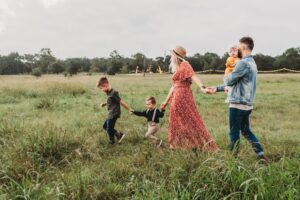Taking family portraits your clients will love for their holiday cards.
October 13th, 2023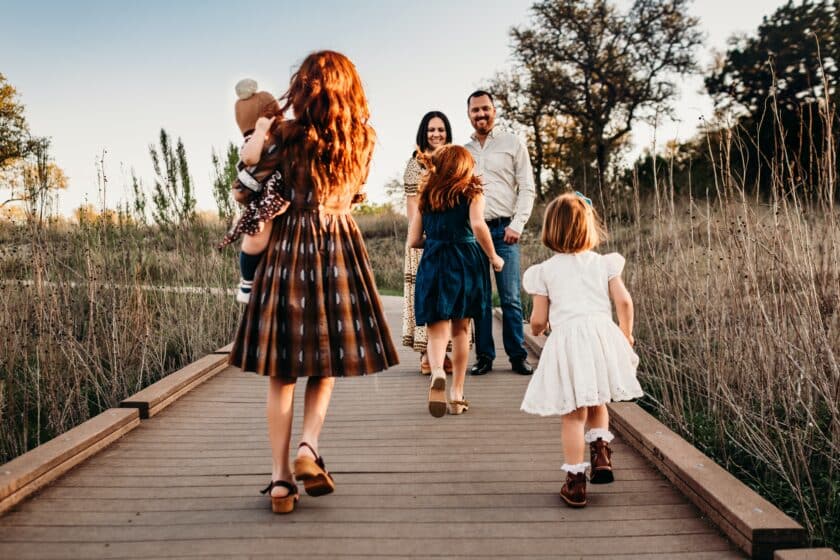
Sending holiday cards featuring family portraits adds a personal and heartfelt touch to the festive season. These cards allow families to convey warm wishes and help bridge the gap with friends and relatives who may not have seen the family recently, providing a sense of connection and closeness. It’s our goal, as photographers, to capture family portraits that our clients are thrilled to print on these cards to be sent out to 100’s of friends and family members.
Here are several tips, tricks, considerations, and time-saving resources you can use to create great family portraits that keep clients coming back to you year after year for their holiday tradition.
Preparing for a family holiday portrait session.
At this point in the season, you’ve likely already determined how many sessions you can take on, and whether or not you will be offering seasonal mini sessions. If the busy season snuck up on you and you’re feeling a little overwhelmed, you might want to set aside a little time to plan and prepare for holiday photoshoots, so you can maximize your profits.
Once you’ve gotten organized, it’s time to prepare for the sessions themselves. We broke this down to help you make choices that are the best fit for your photography brand, style, and your clients’ needs.
Location can set the tone.
Your client might already have an idea of where and how they want their family portrait photographed. With a great online portfolio showcasing your photography style, this will often align with what you most want to shoot, too. Location is often one of the first decisions you and your client will make together, and it will drive the logistics, costs, and even the time of day for the session. Whether you offer location shoots, studio sessions, or both, it is important to make sure you and the client are on the same page. It is best to have a conversation, either over the phone, an online meeting, or in-person chat, so you can ask a few questions. This is a great time to get to know your client and their family so you can get a feel for what they want out of their portrait session. If they don’t have a firm idea of a setting or feel, looking at images in your portfolio and social media together to see which ones they feel most drawn to can help.
If you’re not sure where to begin, here are a few potential questions that help in determining the right setting and tone.
- What kind of location makes your family most comfortable? In studio? At your home, either indoors or outside? Do you have a favorite beach, park, downtown area, or other happy place?
- Which words describe your family best? Silly and playful? Chill and easygoing? Quiet and a bit shy? Active and adventurous?
- Does your family have a favorite shared activity? Playing at the beach? Walking nature paths? Reading stories or playing a game? Making dinner together?
- What shots are the most important for you from this session? Posed with everyone looking at the camera and smiling? Candid moments of certain family members together? Documentary images of the family doing a favorite activity? Detail shots of a growing child?
- How many people will be included in this session? A couple? Parent or parents with x number of children? Extended family such as grandparents, aunts, uncles, and cousins?
- What are the names and ages of the children who will be included in this shoot? Babies, toddlers, school-age, tweens, teens? How about pets?
Once you have a clear idea of who is included and what your client wants, you’ll be able to find a location that suits you both. You’ll also have a good idea of what you might expect during the session, rather than scrambling to adapt when you arrive for the shoot.
Pro tip: Consider adding these or similar questions to your family session questionnaire.
Once the shoot begins, keep your powers of observation on high; look out for potentially distracting messes, items in the foreground or background that could be moved rather than having to edit them out later, and making the best use of your light.
In a studio, consider what furniture, fixtures, backgrounds or other props may be needed to create the vibe your client wants. If your session is in their home, watch for anything in the scene that clutters or detracts from the subjects. Don’t be afraid to ask about minor furniture rearrangements to make best use of the light, and include a variety of standing, kneeling or sitting poses.
Card style and layout.
As you start planning the shoot, another important aspect to consider is the physical card format and style. It can be helpful to share your holiday card designs with your clients before the session and determine their favorite. Knowing upfront that the shot should be vertical or horizontal and whether space is needed for text will help you compose a variety of images to accommodate the final card format.
Portrait orientations often work well for single or couple portraits, and can be great for small family units, too. Landscape orientation is usually ideal for showcasing scenic views in a portrait, or to fit a large or extended family group shot. Maybe your client is thinking about a montage of images, a frame around the photo, or a full bleed card cover. Planning ahead for the final card format will generally prevent cropping and composition issues, making things simpler when it’s time to place the holiday card order.
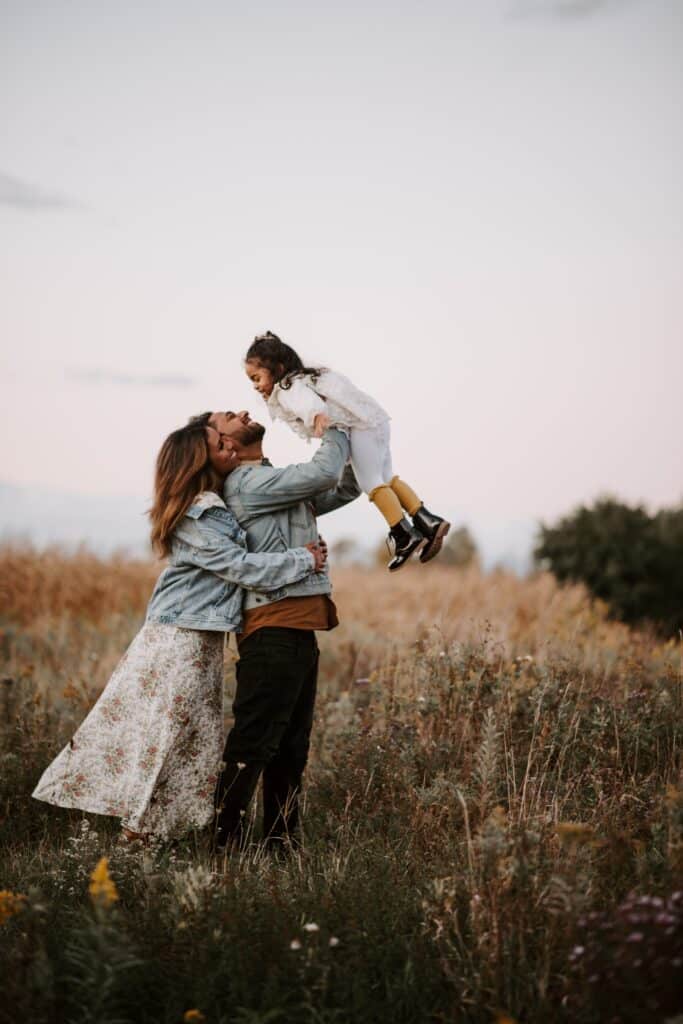
Coordinating the clothing
This detail can cause photographers a lot of stress–this is another part of the process where your portfolio can help you set the tone and find clients who are looking for your style. This often means more than just your editing style and your preference for classic studio portraits or a looser, unposed portrait–it includes the way your clients are styled, too. If you love to photograph families dressed to the nines with their hair and makeup professionally done, make sure that is what you share in your portfolio! Or if your preference is for humorous families that have ugly sweater competitions–show those! The clients who book you based on a portfolio of images you loved to make will be more cooperative when you offer suggestions and tips for how to dress for their photo session…and they’ll love their experience when they get a gallery full of images like the ones they saw on your website.
Some general tips for all clients are to avoid tiny patterns like very thin stripes and checks, and super vibrant colors. These tend not to photograph well, and vibrant colors can cast onto people’s skin and faces, making for an editing nightmare. It is usually best to help them choose a few colors to work within; this will help the group look unified without being overwhelmingly match-y.
No matter what your client and their family decide to wear, encourage them to choose things in which they are comfortable. When someone is uncomfortable or not feeling their best, you can usually see this feeling reflected on their faces.
Schedule and plan effectively.
All of this forethought and planning will pay off for you and your clients from shoot day to card delivery day. By thinking of all the details, and having discussions with clients in advance, you can ensure that the photo session goes smoothly and all variables are covered.
Another part of effective scheduling is to send clear messaging to your newsletter and social following. In your marketing messaging, encourage clients to book their sessions early; if you have limited spots open, it is best to be upfront about it. When discussing session dates and holiday cards, it can be helpful to understand which seasonal holiday clients are sending cards for, and whether they will be mailing them or hand-delivering during their celebrations. Both of these factors can make a big impact on client deadlines–and how much time you have for editing their session. Once you have this info, work backwards from the client’s desired date for receiving their printed holiday cards. Give yourself a realistic amount of time for culling, editing, and client review.
Online booking and scheduling tools can be a very easy and effective way to let clients see your availability based on your calendar, book their preferred date and time, and even pre-pay for a service package. Some booking tools will automatically create a client gallery within your website when a booking is complete–this is a great example of utilizing workflows to make the busy season less stressful. Client galleries that include tools for proofing, commenting, and ordering from integrated labs can further reduce your workload. It‘s important to check printing and shipping times with your labs during the holidays, too, as both of these might take a bit longer than usual.
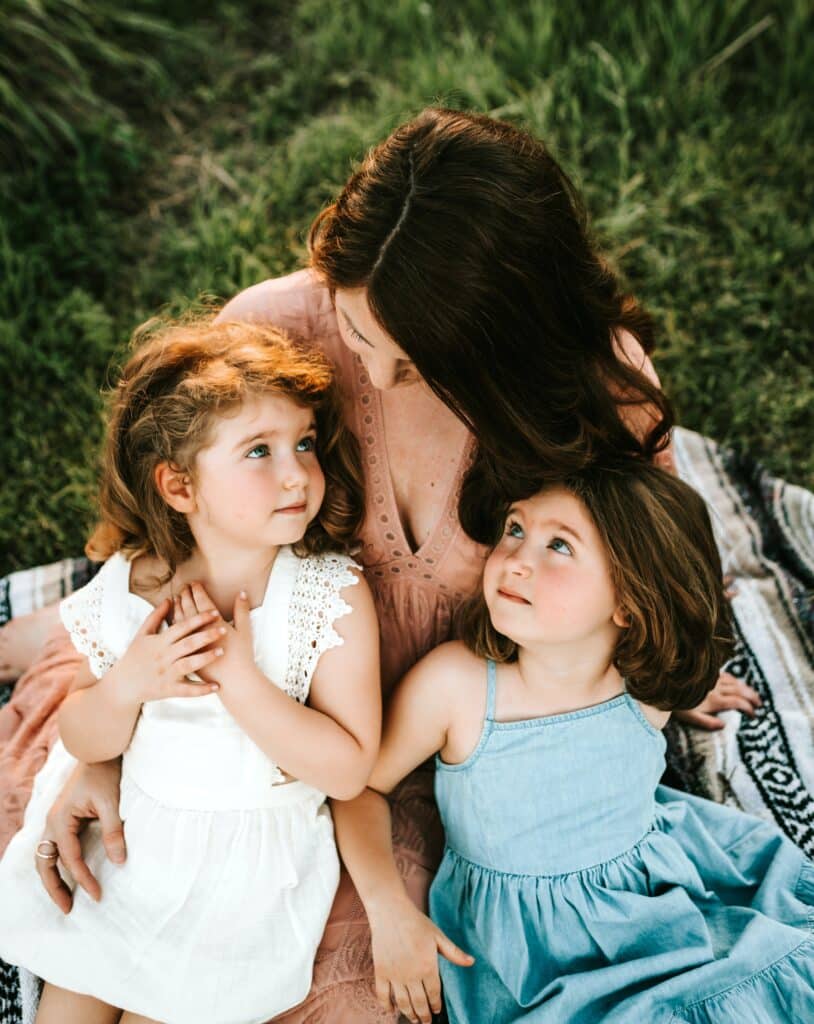
Finding the balance between poses, prompts, and candid connections.
By the time the session comes around, you should have a good sense of your client’s personality, and they should have an understanding about how the session will go. Clear communication leading up to the session about what to expect from the experience goes a long way to making clients and their family more comfortable in front of the camera. It helps to reinforce this with them briefly as the session begins. If your style is more traditional or even somewhat formal, you can let them know you will be giving them lots of direction about posing and when to look at the camera.
For a more relaxed and candid shooting style, you can remind the family that there will be prompts and some direction from you, but the focus is on having fun and connecting together as a family–perfection not required! Especially when photographing families with young children, meltdowns can happen–letting parents know that this is normal can help keep their stress down if it occurs.
Here are a few posing ideas in case you get stuck:
- Standing: Connect their bodies by having them turn towards each other instead of the camera, and rest their hands naturally on each other’s waists, children’s shoulders, etc. Ask them to lean into one another–heads can rest against arms or shoulders, and small children can wrap their arms around parent’s legs. From there, you can mix things up by moving around, having them look at you and each other, and use prompts to promote natural connection and emotions.
- Sitting: Pose families with legs out to the sides, rather than straight out. This will naturally encourage them to lean toward each other and create diagonal lines. Children can lean against their parents or place their heads and shoulders in their laps. Using their bodies to create triangular or diamond shapes and including diagonal lines will give you a visually strong image.
- Walking and/or playing: This is a great way to give clients a little break and catch some candid moments between spots in your shooting location. It could be walking toward or away from the camera, or even across the frame. Mix it up by having the family pair up for holding hands in some shots, running ahead, all holding hands together–and allow space for their natural interactions to come through. If playing, allow time for splashing in the water at a beach, jumping on a trampoline at home, or having a tickle-fight in a field–the possibilities are endless when you let kids and parents take the lead here. Some of the best family holiday portraits are of the subjects looking at each other, rather than at the camera.
- Change perspective: We’ve all done it–we find a great shot, snap a few images, and then in our rush of capturing that vision, we forget to explore other angles. Sometimes the best shots can be the ones we didn’t plan. After getting your initial shot, move yourself around your clients, shooting from the sides, farther back, getting in close for details, and shooting from above or below. Not only does this give you time to get creative, it will add a lot of variety to the final gallery with very little change to the pose.
- Individual portraits: Whether the family is large or small, take a few minutes to get solo portraits of the children and couple shots of the parents, grandparents, etc. These can be great additions to a holiday card, or make excellent photo gifts for the holiday season.
Whether in a studio, their home, or outdoors in a scenic location, whether it is formal or relaxed, allow time for getting silly and having fun. These candid shots of the family will often be some of the favorites, and can end up being included in holiday cards.
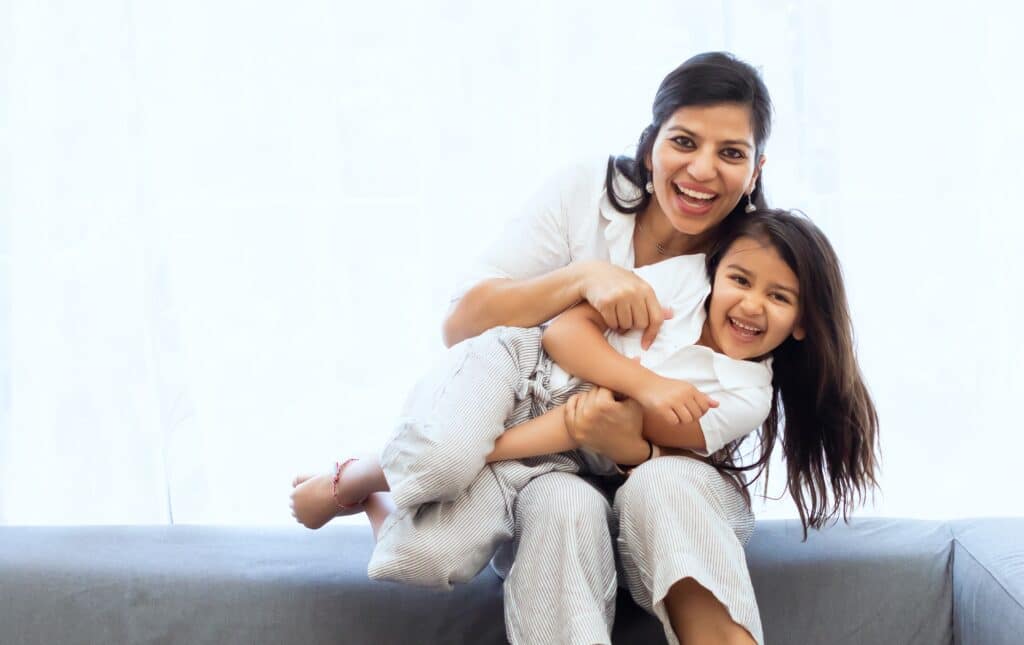
Equipment, settings, and composition.
The best camera and lighting gear for family portraits should be based on your studio or location setting. If you are in studio, you will likely have everything set and at your fingertips to achieve the best focal length and lighting effects for your images. For traveling on location, all that advance planning will help you decide how to pack your gear bag.
Lenses
In a studio, a standard to moderately wide aperture prime lens will likely be your best option. A sharp, fast lens with either standard 50mm or wide-angle 35mm focal length will accommodate most group sizes. Portrait photographers generally avoid shooting wider than 35mm, as the people closer to the edge of the frame will be distorted.With extra large family groups, consider the size of the studio and consider an outdoor location if there is not ample room for multiple poses using your standard lenses.
On location you may want a wider variety of lens options or a zoom lens. For an outdoor setting like a park, you have the option to be farther away from your subjects and to try various walking and active poses. In addition to your wide-angle and standard lenses, consider packing a 85mm f/1.8 prime lens or a 70-200mm f/2.8 zoom lens in your bag, along with your favorite 50mm or 35mm. This should give you plenty of lens adaptability for any remote setting and size of family.
Lighting family portraits
If your client prefers an outdoor setting for their photo session, choosing the right time of day for family portraits can make a world of difference. When you’re not equipped with off-camera lighting, natural light becomes your best friend. The golden hours, typically within the first two hours after sunrise and the last two hours before sunset, offer the most flattering and softest lighting conditions. During these times, the sun is low on the horizon, casting a warm, gentle glow that minimizes harsh shadows and creates a beautiful, even illumination on your subjects. Midday sun can be harsh and lead to unflattering highlights and shadows, so it’s best to avoid shooting family groups during those hours if possible.
When the golden hours for photography are not an option there are still ways to capture stunning family portraits. Opt for shaded areas or open shade, such as under trees or near neutral-toned buildings, to soften the harsh midday sun.
Lighting a family portrait in a studio setting provides complete control over the lighting environment, allowing photographers to craft their desired illumination for their subjects. Studio lighting typically involves a combination of key lights, fill lights, and background lights. The key light serves as the primary source of illumination, casting directional light onto the family, while the fill light softens shadows and ensures even exposure. Background lights can be used to separate the subjects from the background, creating depth and dimension. With precise adjustments to these elements, photographers can sculpt and enhance the features of their subjects, resulting in beautifully lit family portraits that highlight the warmth and connection of the family members. Studio lighting offers versatility, consistency, and the ability to achieve a wide range of creative effects.
Depth of field: Bokeh
Whether you are outside, in the family’s home, or in a studio, don’t let a busy background detract from the emphasis on your family faces. Make the background blur a bit by using a wide aperture to create shallower depth-of-field. In outdoor locations, this is where your 85mm lens can really shine, delivering a creamy bokeh from the compression and blur of the background.
In the studio, you can also lessen background attention with lighting techniques to make the background darker or significantly lighter than your subjects.
When working with a shallow depth of field and large groups, remember that the placement of your subjects is important. The shallower your depth of field, the closer everyone needs to be to the same line of focus to avoid blurry faces. When placing family members behind each other, don’t go too shallow–with multiple layers of people, an aperture setting of f3.5 to f5 is usually a safe range.
With larger groups, you can still achieve great bokeh by placing your subjects farther from the background, placing the background well outside the focal plane.
Negative space
It can be fun to use negative space as a creative tool, even when not shooting family portraits with holiday cards in mind. If your client prefers a card design that includes text overlays on their image, plan several shots in each pose to include negative space or a neutral, out of focus foreground. This will ensure there’s enough space in the composition to accommodate the desired text or a message, or allow for cropping their favorite image for a card design that includes multiple images.
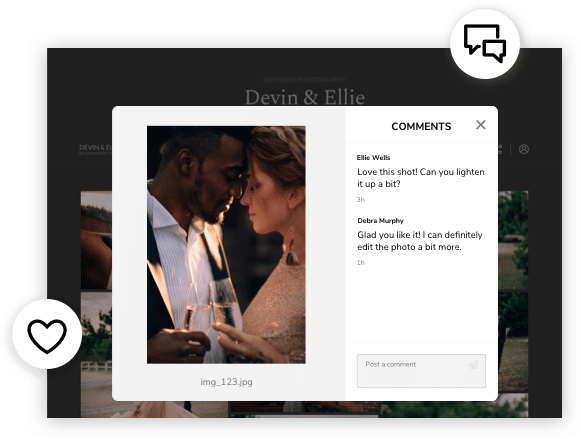
Use an online portfolio website for gallery delivery.
Busy family portrait photographers need reliable resources to ensure that sessions get scheduled, payment is taken, beautiful client galleries are delivered, and the families receive professionally printed cards to their doorstep in a timely manner.
Many family portrait photographers create beautiful online website portfolios to showcase their work and attract new clients. Some platforms also include effective search-engine optimization and social media integration with platforms like Instagram and Facebook.
Delivering client galleries is even simpler when your online portfolio website is an all-in-one solution. The simplicity of having a gallery settings that allow you to share client galleries via email or direct links–and for clients to choose favorites, add comments or retouching requests, download photos, and purchase their holiday cards and other photo gifts all from one location–can’t be underrated during busy season.
Customizable e-commerce tools enable family portrait photographers to communicate about requests and sell their images directly to clients in an easy, streamlined workflow. With integrated labs, many aspects of the selling process after a shoot are automated and require little or no extra effort on the part of the photographer to get downloads, prints and holiday cards delivered directly to your clients.
You can make this holiday season very productive for your photography business with a special focus on family portraits and selling holiday cards. Even if you offer client families the option to purchase digital files for e-cards, using some of the tips we covered is sure to make your clients happy so they return year-after-year.

